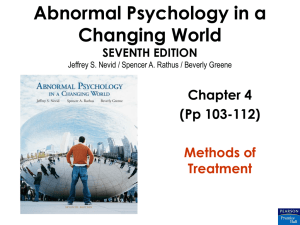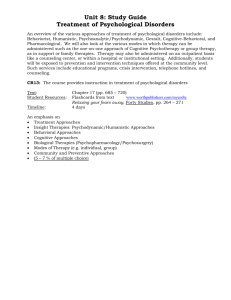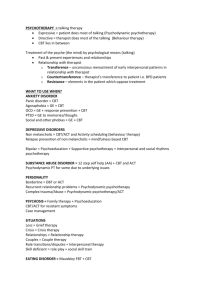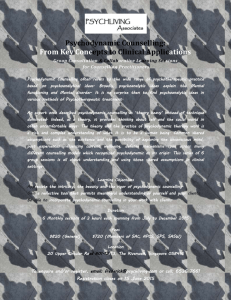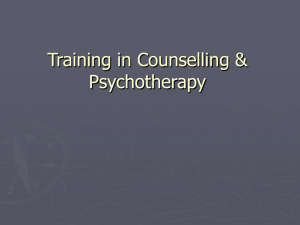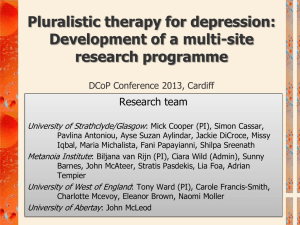Modalities in Practice
advertisement
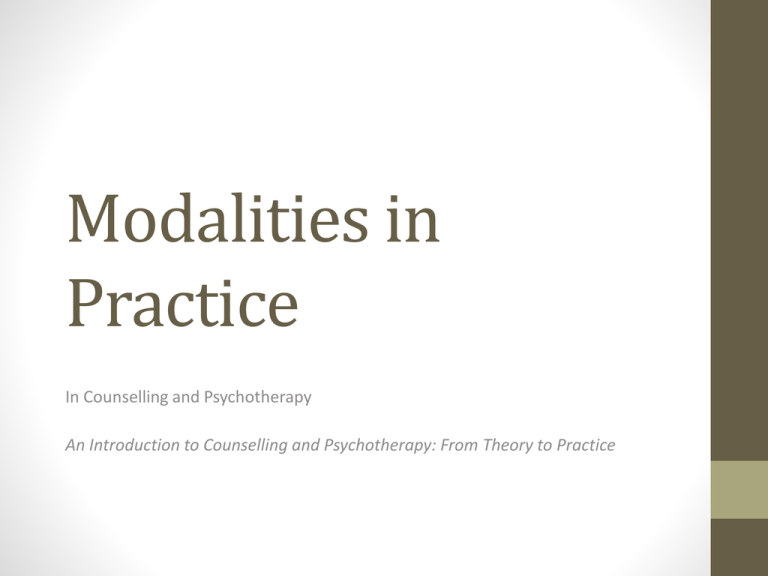
Modalities in Practice In Counselling and Psychotherapy An Introduction to Counselling and Psychotherapy: From Theory to Practice Overview of Modalities • It is said there is in excess of 450 different approaches to counselling and psychotherapy • Much debate as to the relative efficacy of different approaches • Training closely linked to modality • The majority of the mainstream approaches can be considered under one of four primary ‘umbrella’ headings: • • • • Psychodynamic approaches Humanistic approaches Cognitive-behavioural approaches Integrative or pluralistic approaches. Psychodynamic Approach • Psychoanalysis shaped and informed by work of Freud (1856– 1939) and his contemporaries, including Jung 1875–1961), Adler (1870–1937) and Klein (1882–1960) • Contemporary psychodynamic practice, while informed by ideas from psychoanalysis, also informed by theories of attachment developed initially by Bowlby (1907–1990) • Therapeutic work strongly incorporates concepts of the unconscious and how that shapes and informs thoughts, feelings and behaviours • Task of therapy includes bringing unconscious processes into conscious awareness • Key concepts include transference, countertransference, object relationships and projective identification. Humanistic Approaches • Humanistic approaches developed in the US in the 1940s and 1950s onwards, drawing on concepts of humanistic psychology • Many of the concepts of psychoanalysis and behavioural therapy were rejected by key theorists, including Maslow (1908–1970), Rogers (1902–1987) and Moustakas (b. 1923) • Rogers’ assertion was that individuals, given the right conditions, have the capacity to change and move towards a position of health and growth • A number of discrete approaches come under the ‘humanistic’ umbrella, each with specific theoretical concepts, including: person-centred; gestalt; and transactional analysis. Cognitive-Behavioural Approach • Cognitive-behavioural approaches (therapy) (CBT) are an integration of behavioural and cognitive therapy • Early proponents of behaviourism included Pavlov (1849– 1936) and B. F. Skinner (1904–1990), while key theorists of cognitive therapy include Beck (b. 1921) and Ellis (1913–2007) • CBT assumes that change in behaviour and cognition (thinking) can lead to change at an emotional level, thus leading to a reduction in distress and the alleviation of symptoms • There are a number of approaches that fall under the CBT umbrella, including Rational Emotive Behaviour Therapy (REBT), Cognitive Analytic Therapy (CAT) and CompassionBased Therapy. Integrative & Pluralistic Approaches • Integrative therapy draws on a number of principles and ideas from key therapies and integrate them into a new whole (e.g., drawing from psychodynamic and person-centred therapies) • Integrative approaches are distinct from eclectic approaches, where the latter draws on techniques and interventions in a ‘as and when’ basis • Cooper and McLeod (2010, p. 9) state that a pluralistic approach is based on the, ‘assumption that different clients are likely to benefit from different therapeutic methods at different points in time, and that therapists should work collaboratively with clients to help them identify what they want from therapy and how they might achieve it.’ Cooper, M. and McLeod, J. (2010) Pluralistic Counselling and Psychotherapy. London: Sage. Approaches in Practice • All main approaches outlined here can be found in a variety of settings, including: • • • • Health care settings, including primary and secondary care Social care settings The third sector Independent practice • The last few years has seen a particular emergence of CBT in health-care settings, partly due to an abundance of quantitative research evidence (e.g., RCTs), and partly due to the commissioning of IAPT services for adults and latterly for children and young people • Research evidence supports the use of all four umbrella approaches with a range of different client presentations.

